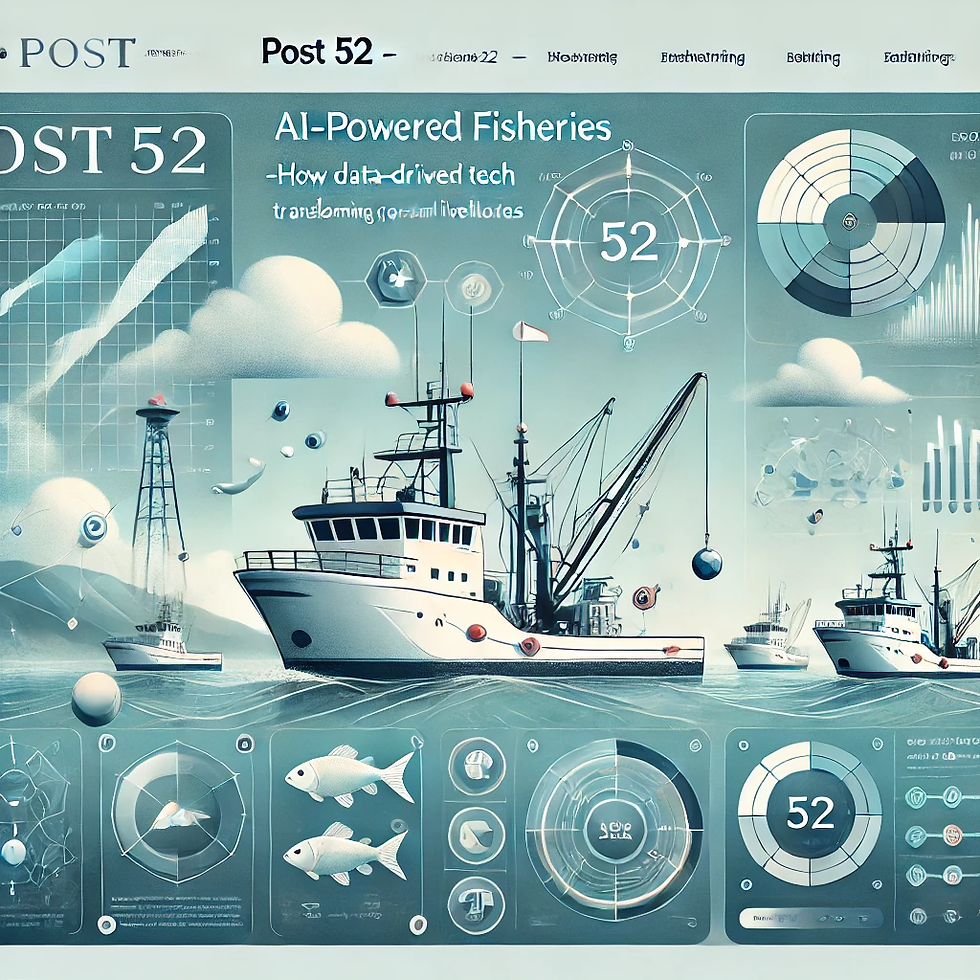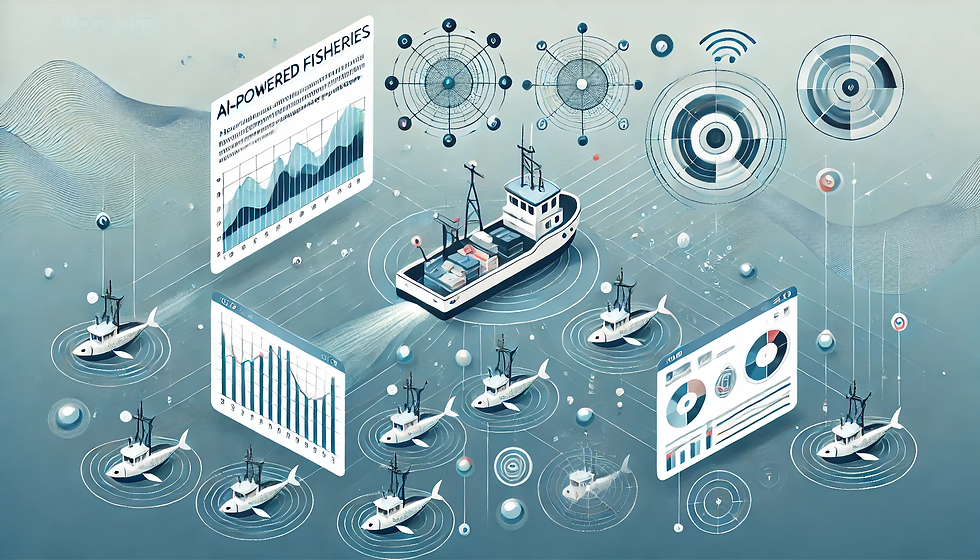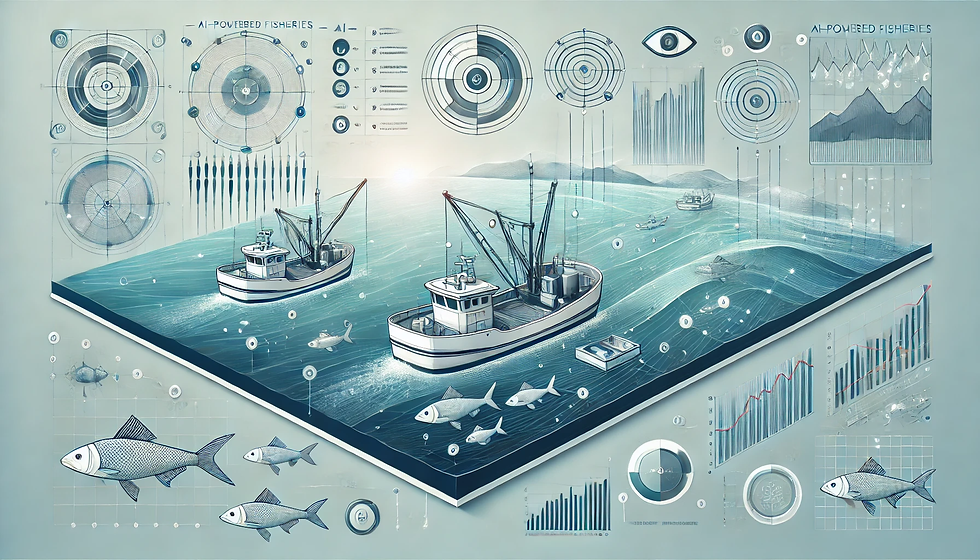Post #52: AI-Powered Fisheries – How Data-Driven Tech is Transforming Coastal Livelihoods
- henry belfiori
- Feb 14
- 8 min read

Hello and welcome!
This week, I’ve taken a brief dive into how AI-powered fisheries actually work, focusing on the tech behind the data, how it’s processed, and why it matters.
Next week, I’ll be shifting focus to the startups actually building this technology—who’s leading the charge in AI-driven fisheries, and how they’re bringing these innovations to life. If you know of any exciting companies in this space, drop me a message!
Enjoy!
1 - The Core Technology Behind AI-Powered Fisheries
For centuries, coastal fishing communities have relied on traditional knowledge and manual techniques to sustain their livelihoods. However, growing challenges such as overfishing, climate change, dwindling fish stocks, and competition from industrial fleets have put immense pressure on small-scale fishers. Many struggle to predict catch volumes, locate fish efficiently, and secure fair prices for their harvest, making their work increasingly unsustainable and financially precarious.
This is where artificial intelligence (AI) and data-driven fisheries management come in. By leveraging satellite tracking, IoT-enabled sensors, big data analytics, and machine learning, AI is revolutionising the way fisheries operate—optimizing catch efficiency, preventing illegal fishing, improving market access, and ensuring long-term sustainability.
But how does all this work under the hood? Let’s see that engine.
1.1 Data Collection: The Backbone of AI-Driven Fisheries
AI in fisheries starts with data—and a lot of it. The more accurate and diverse the data sources, the better the predictions and insights. Here’s how it all gets collected:
📡 Smart Buoys & IoT Sensors
Fitted with environmental monitoring devices, these buoys and floating sensors track ocean conditions in real-time. They gather crucial data on:
Water temperature & salinity – Helps determine fish migration patterns.
Oxygen levels – Low levels signal potential fish die-offs.
Algal blooms & pollution levels – Prevents fishing in hazardous zones.
The AI continuously processes this data to predict the best fishing zones and alert fishers to avoid depleted or unsafe areas.
🚢 GPS & Vessel Tracking Systems
AI-driven GPS tracking is used to map out fishing activities and analyse vessel movement patterns. This helps:
Identify overfished areas before they become unsustainable.
Prevent illegal fishing by flagging suspicious activities.
Optimise routes to reduce fuel consumption and operational costs.
Some systems even use historical GPS data to detect fraudulent fishing reports, making enforcement more effective.
🦈 AI-Powered Sonar & Acoustic Sensors
Sonar and hydrophone arrays are used to detect fish movements, classify species, and estimate biomass. Unlike traditional sonar, AI-enhanced versions can:
Identify specific fish species in real-time using machine learning.
Track fish density trends, helping fishers avoid overfishing.
Detect predator activity to warn fish farms and fishers.
These sensors eliminate guesswork, allowing fishers to target sustainable catches more effectively.
🛰️ Satellite Imaging & Remote Sensing
Satellite remote sensing uses AI to track oceanic changes at a global scale. These satellites monitor:
Chlorophyll levels, indicating plankton blooms (which attract fish).
Sea surface temperatures, which drive fish migration.
Marine protected areas, helping regulators enforce conservation policies.
AI algorithms process these datasets in real-time, sending predictive fishing insights directly to fishers’ devices.
1.2 Data Processing & AI Algorithms: Making Sense of the Ocean
With billions of data points streaming in, AI models must process this vast ocean of information at lightning speed. Here’s how:
🧠 Machine Learning Models for Catch Prediction
AI-powered models analyse historical catch data, ocean conditions, and migration patterns to predict where fish will be next. These predictions:
Reduce wasted trips to unproductive areas.
Increase efficiency, meaning less fuel spent and lower costs.
Prevent overfishing by helping fishers time their hauls sustainably.
By continuously refining its forecasts, AI can adapt to climate-driven shifts in fish behaviour faster than any human expert.
👀 Neural Networks for Species Recognition
Traditional fishing methods often accidentally capture endangered species. AI-powered cameras and onboard imaging systems use deep learning to classify species in real-time.
Instant bycatch detection – If a protected species is caught, AI alerts the crew to release it.
Improved compliance – Automates reporting for fishing regulations.
Smarter processing – AI can even sort fish by size and species before they reach port.
This means fewer fines, less waste, and a more sustainable fishing industry.
📊 Big Data Analytics for Fishery Health & Stock Assessments
AI doesn’t just predict where fish are—it also tracks long-term ecosystem health.
By analysing data from thousands of sources, AI can forecast fish stock depletion risks.
Fisheries can use data-backed decisions to set more accurate quotas.
Governments and conservationists can intervene early to prevent collapses.
This level of precision was impossible just a decade ago, but AI is now making real-time stock management a reality.
🚨 AI-Powered Illegal Fishing Detection
Illegal, Unreported, and Unregulated (IUU) fishing is a £20 billion global problem. AI-driven surveillance systems are changing that.
Satellite AI detects “dark fleets” – Vessels that turn off their GPS to avoid detection.
Pattern analysis spots anomalies – AI compares vessel movement against legal fishing routes.
Instant alerts sent to authorities, making enforcement far more effective.
This tech protects legal fishers, prevents overexploitation, and helps coastal communities defend their waters.
1.3 AI-Driven Decision-Making & Automation
AI is also helping fishers directly, providing real-time guidance and market insights.
📲 AI-Enabled Mobile Apps for Fishers
Many AI-powered fisheries systems now include smartphone apps that:
Give live updates on best fishing spots.
Predict market prices, so fishers know when and where to sell.
Send alerts on changing regulations, helping fishers stay compliant.
This is game-changing for small-scale and remote coastal fishers who previously had no access to such advanced insights.
💰 AI-Optimised Pricing & Digital Marketplaces
AI can even analyse fish market trends and suggest the best times to sell.
Supply & demand models prevent price crashes during overabundant catches.
Blockchain-backed fish tracking allows consumers to verify sustainable sourcing, leading to premium pricing for responsible fishers.
This not only helps small fishers earn more but also promotes sustainability.
Summary: A Smart Future for Fisheries
From predicting fish stocks to enforcing conservation, AI is transforming fisheries from a trial-and-error practice into a precise, data-driven industry. By leveraging AI’s power, we can:
✅ Protect fish stocks for future generations.
✅ Increase efficiency and reduce costs for small-scale fishers.
✅ Prevent illegal fishing and exploitation of coastal communities.
✅ Improve transparency and fair pricing through digital marketplaces.
AI isn’t just a luxury for large industrial fisheries—it’s becoming an essential tool for sustainable and profitable fishing, especially for coastal communities that need it most.

2 - How AI-Powered Fisheries Support Coastal Communities & Reduce Poverty
While AI-driven fisheries technology is impressive from a data and automation standpoint, its true value lies in how it transforms the livelihoods of coastal fishing communities. For many small-scale fishers, fishing isn’t just a job—it’s a way of life, a food source, and often their only means of income. However, climate change, overfishing, and market volatility have made traditional fishing more unpredictable and financially unstable.
AI is stepping in to help these communities fish smarter, earn more, and sustain their resources for future generations. Let’s explore how.
2.1 Increasing Productivity & Reducing Costs
For many coastal fishers, every trip out to sea is a gamble. AI helps turn that gamble into a calculated decision by improving catch efficiency and reducing operational costs.
🔹 AI-Powered Catch Prediction – Instead of wasting time and fuel searching for fish, AI algorithms analyse ocean conditions, fish migration data, and real-time satellite imagery to pinpoint the best fishing zones.
🔹 Smart Routing for Fuel Efficiency – AI suggests optimal routes based on tides, weather, and fish location, helping fishers save up to 30% on fuel costs.
🔹 Reduced Bycatch & Wastage – AI-driven species recognition and sonar helps avoid overfished species, reducing waste and preventing accidental fines for catching protected species.
For small-scale fishers with tight profit margins, even a small efficiency boost can make the difference between a sustainable business and financial struggle.
2.2 Protecting Small-Scale Fishers from Industrial Competition
Large industrial fleets, often backed by huge subsidies and advanced tech, dominate the fishing industry, leaving small fishers at a disadvantage. AI helps level the playing field by:
🔹 Illegal Fishing Detection – AI-powered satellite tracking can identify and flag unlicensed vessels that operate in restricted waters, helping authorities enforce laws and protect local fishing rights.
🔹 Real-Time Alerts – Small fishers receive instant updates when large trawlers enter their waters, allowing them to relocate or take action.
🔹 Digital Catch Tracking – Blockchain-based AI tracking systems ensure fishing quotas and sustainability policies are upheld, preventing industrial fleets from overexploiting resources at the expense of local communities.
AI acts as a digital watchdog, ensuring that small-scale fishers don’t lose access to their traditional fishing grounds.
2.3 Strengthening Fish Stock & Ensuring Long-Term Sustainability
Many small fishing communities face depleting fish stocks due to poor management and climate-related disruptions. AI-driven fisheries provide real-time monitoring and long-term sustainability planning:
🔹 AI-Optimised Fishing Quotas – Instead of fixed quotas, AI adjusts in real-time based on fish stock data, ensuring fish populations remain stable.
🔹 Ecosystem Health Tracking – AI aggregates data from satellites, buoys, and sensors to detect habitat destruction, pollution, and overfishing risks before they become critical.
🔹 Regeneration Planning – AI helps governments and local cooperatives identify the best areas for conservation efforts, ensuring fish populations recover faster.
By integrating AI into marine management, small fishers can ensure they’ll have a viable industry to pass on to future generations.
2.4 Enabling Access to Better Markets & Fairer Prices
Coastal fishers often have no control over pricing, relying on middlemen and wholesalers who dictate market rates. AI-driven digital marketplaces are changing this dynamic:
🔹 AI-Driven Fish Pricing – AI analyses market trends and consumer demand to suggest the best times and locations to sell, maximising profits for small-scale fishers.
🔹 Direct-to-Consumer Platforms – AI-backed traceability systems (often using blockchain) allow fishers to sell directly to restaurants and eco-conscious consumers, cutting out middlemen.
🔹 Sustainability Premiums – Fish caught using AI-monitored sustainable practices can receive certifications and traceability tags, increasing their value in premium markets.
Instead of being price-takers, AI gives small fishers more control over their earnings and access to higher-value markets.
Summary - AI as a Lifeline for Coastal Communities
AI isn’t just a tool for efficiency—it’s a lifeline for coastal communities struggling with economic instability, overfishing, and industrial competition. By cutting costs, increasing yields, enforcing fair trade, and ensuring sustainability, AI-driven fisheries are reshaping the economic landscape for small-scale fishers, lifting them out of poverty while protecting the ocean. As this technology becomes more accessible, its potential to transform coastal economies worldwide is only just beginning.

Final Remarks
Thanks for reading! To me, AI in fisheries is one of the most exciting intersections of tech, sustainability, and economic empowerment, and it’s only just getting started. While this post focused on the tech itself, next week I’ll be mapping out startups developing AI solutions for fisheries—who’s out there, what they’re building, and how they’re scaling these innovations.
If you’re working in this space or know a company that deserves a spotlight, let me know. Until next week! 🚀🌊
Warm wishes and peace
H
“The sea, the great unifier, is man’s only hope. Now, as never before, the old phrase has a literal meaning: we are all in the same boat.” – Jacques Cousteau
Sources
1. The Core Technology Behind AI-Powered Fisheries
https://www.fao.org/3/cb2335en/cb2335en.pdf (FAO Report on AI in Fisheries)
https://www.nature.com/articles/s41467-021-26391-3 (Machine Learning for Fisheries Management)
https://oceanmind.global/technology/ (OceanMind’s AI-powered Fisheries Monitoring)
https://www.weforum.org/agenda/2023/05/ai-fisheries-sustainability/ (How AI is Making Fisheries More Sustainable)
https://www.nationalgeographic.com/environment/article/satellite-surveillance-ai-detect-illegal-fishing (AI & Satellites for Illegal Fishing)
2. How AI-Powered Fisheries Support Coastal Communities & Reduce Poverty
https://www.worldbank.org/en/news/feature/2021/06/08/the-blue-economy-and-coastal-poverty (Blue Economy & Coastal Poverty)
https://www.sciencedirect.com/science/article/abs/pii/S0308597X22000572 (AI and Economic Benefits for Small-Scale Fisheries)
https://www.undp.org/blog/technology-oceans-and-poverty-reduction (UNDP on AI, Marine Tech & Coastal Development)
https://www.frontiersin.org/articles/10.3389/fmars.2022.1038913/full (Fisheries Data Analytics for Market Access)
https://www.mdpi.com/2071-1050/14/12/7133 (Blockchain & AI for Fair Trade in Fisheries)
Comments